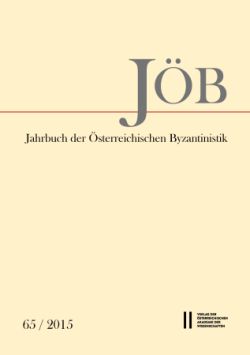Ewald KISLINGER
ist Professor am Institut für Byzantinistik und Neogräzistik der Universität Wien
|
 |
Artikel:
Christoph BEGASS, Der Brief des Paulos Helladikos (CPG 7531). Autor, Datierung und Kontext
Petros BOURAS-VALLIANATOS, A new witness to Michael Psellos’ poem “On Medicine” (“De medicina”)
Christian GASTGEBER, Das Dossier der documenta byzantina des 2. Konzils von Lyon (1274).
Ein bislang unbekannter Rotulus aus dem Umfeld eines Konzilsteilnehmers, des Salzburger Erzbischofs Friedrich von Walchen (mit einer Textabbildung)
Adam IZDEBSKI – Grzegorz KOLOCH – Tymon SŁOCZYŃSKI, , Exploring Byzantine and Ottoman economic history with the use of palynological data: a quantitative approach (with one map and 32 figures)
Dirk KRAUSMÜLLER, Diorasis denied. Opposition to clairvoyance in Byzantium from late Antiquity to the eleventh century
Katrien LEVRIE, La Syllogé contre les Latins de Théodore Agallianos. Édition critique
Dimitrios LIAKOS, The Byzantine bell-tower in Vatopedi Monastery on Mount Athos (1427). The sculpted decoration and its significance (with 24 figures)
Charis MESSIS – Ingela NILSSON, Constatin Manassès, La description d`un petit homme. Introduction, texte, traduction et commentaires
Johannes PREISER-KAPELLER, A collapse of the Eastern Mediterranean? New results and theories
on the interplay between climate and societies in Byzantium and the Near East, ca.
1000–1200 AD. (with seven appendices, including three tables and 33 figures)
Alexander RIEHLE, Epistolographie und Astronomie in der frühen Palaiologenzeit. Ein bislang
unedierter Brief des Nikolaos Rhabdas an Andronikos Zarides aus dem Jahr 1321
|



